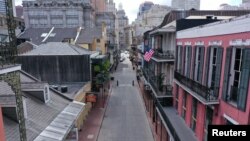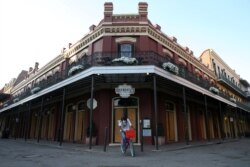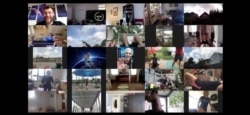Southern Louisiana is no stranger to disasters and sudden loss of life. The region still bears the scars of Hurricane Katrina in 2005, the 2010 BP oil spill and Baton Rouge's catastrophic flooding in 2016.
Now the region finds itself a hotspot of the coronavirus pandemic. As of Tuesday night, the state recorded 5,237 COVID-19 cases and 239 deaths. The numbers are expected to spike further as Gov. John Bel Edwards recently noted Louisiana was experiencing "the fastest growth rate of confirmed cases in the world."
Many of those deaths occurred in and around New Orleans. As the city's convention center is converted to a make-shift hospital and the municipality awaits federal aid, residents see similarities to disasters of the past as well as factors making this crisis unique and unfamiliar.
“COVID-19 is like Katrina in slow motion,” says Peter Breen, owner of a New Orleans barbecue restaurant he co-founded with his wife in 2004. Breen says it was six weeks before he could reopen after the hurricane. He recalls the business survived and eventually grew by catering to a nearby naval base and volunteers arriving in town to rebuild.
The COVID-19 pandemic feels different, he says. “This time we have a growing threat with no identifiable end point. Business is down and I expect that to continue until whenever it is we get some good news.”
Unique to New Orleans
City officials announced on Tuesday they expect New Orleans’ death rate to reach 5% of all local confirmed COVID-19 cases. This far exceeds the average rate across the United States of less than 2%.
Experts suggest it’s no accident the city has been hit harder than elsewhere in the country. There is a growing sense that the city’s economy — relying heavily on tourism from as many as 17 million visitors each year — facilitated the virus’ spread.
“Our economy revolves around people gathering in the public space,” explains Richard Campanella, a geographer, author and professor at Tulane University, “whether that be festivals, music clubs, the restaurant scene or second-lines [large parades].”
The city’s world-famous Mardi Gras celebration attracts more than one million visitors each year and brings together hundreds of thousands of local residents. The festivities were held as usual this year, extending through most of February, precisely when the coronavirus was taking a foothold in America.
Once spreading in the city, New Orleans is proving to be especially vulnerable. The Centers for Disease Control and Prevention (CDC) advises that diabetes and heart disease increase the risk of severe COVID-19 illness, and New Orleans has higher rates of both conditions than the national average. Socio-economic factors also play a role.
“We’re a city with a high rate of poverty, and that can sometimes lead to these underlying health issues because of less access to quality foods and proper healthcare,” says Mollie Pate, a gym owner and local musician. “Now we’re seeing people with those health issues are most likely to be impacted.”
Struggling economy
In addition to a health emergency, COVID-19 is taking a devastating economic toll as tourism disappears and employers lay off workers, says United Way of Southeast Louisiana CEO Michael Williamson.
“Certain factors about the local community will make the effects of the coronavirus pandemic particularly harsh,” he explains, noting that hospitality and tourism employ 72,000 workers in the New Orleans metropolitan area, or 12% of the workforce.
“A large majority of these positions pay low wages,” he says, “leaving households with little savings to weather a crisis like losing a job during COVID-19.”
United Way has sprung to action, creating the Hospitality Cares Pandemic Response Fund. The program provides grants to hospitality workers in the area unable to cover basic needs during the emergency. The application launched last week and elicited a flood of applications, more than 2,000 in a matter of hours, forcing a temporary suspension of the program while applications were processed and additional funds were raised.
Meanwhile, local workers continue to struggle.
“The current crisis has decimated my income,” says Kelcy Mae Wilburn, a musician in the New Orleans band Ever More Nest, as well as a writer. “The local publisher I’ve worked for had to drop my freelance services, and months of my band’s performances have been cancelled or postponed. It’s a lot to overcome, and so many in New Orleans are affected in similar ways.”
Déjà vu or welcome change?
Like other cities and townships across the country, New Orleans waits for promised relief from the federal government to help mitigate the growing crisis. Officials say aid can’t come soon enough.
Gov. Edwards announced Louisiana was offered 150 additional ventilators for hospitals this week by the Strategic National Stockpile, far short of the 5,000 the governor requested. The state says it may no longer have enough ventilators for critically ill patients by April 4.
Local businesses and individuals also await assistance from the $2 trillion stimulus package President Trump signed into law last week. The legislation will provide additional unemployment benefits for affected workers and loans for impacted businesses.
For many in New Orleans, empty streets, closed stores, ad-hoc schooling, massive layoffs and the government’s commandeering of the convention center bring back memories of Hurricane Katrina’s aftermath, when federal aid came notoriously late as the city’s death toll rose and scenes of frantic desperation abounded. Some in the city say they are hesitant to count on federal assistance again.
Gabie Sonnier is general manager of Gabrielle Restaurant. She remembers the eatery flooding during Katrina, when she was a child, and the difficulty her parents had getting insurance payments. As a result, she says, the restaurant didn’t reopen for 12 years.
“Based on our experience during Katrina,” Sonnier says, “we know we can’t depend on government assistance to reopen our doors this time.”
Most, however, say they are eager for aid, even if they’re skeptical of the long-term effect it will have.
“I think these unemployment benefits are going to be really helpful for a lot of people. At least for a month or two,” says Marie Corbett, a recently laid off manager of a popular neighborhood bar. “I have two kids, though, and it’s hard not to think about the future. What will people do when this aid runs out? We’ll wait until it’s safe, of course, but I think we’re all just eager to get back to work.”










